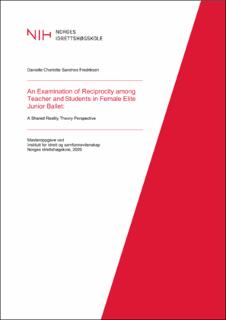| dc.description.abstract | When performing at the elite level in female elite junior ballet, the teacher-student relationship is crucial in reaching performance development (Jowett, 2017). Shared Reality Theory (SRT; Echterhoff & Higgins, 2018; Higgins, 2019) holds significant potential for studying the reciprocity in the relationship between people. Thus, the purpose of the present study was to explore (a) how a shared reality (Higgins, 2019) is established, or fails to be established, over the course of the dancing partnership between the teacher and his/her ballet students; and (b) how experiencing a shared reality (or not) in the teacher-student relationship is related to the experienced quality of the relationship the teacher and his/her ballet students develop and maintain over the course of a 8-month period.
Three female elite junior ballet students and their primary ballet teacher were purposefully sampled and examined using a semi-structured interview (Patton, 2014). To explore the participants’ experiences, we used narrative inquiry and analyzed the data through an inductive and deductive approach (Clandinin & Connelly, 2000; Smith & Sparkes, 2009a, 2009b). The narrative analysis showed that there was a shared reality in the teacher-student relationship on an epistemological level. However, findings indicated that achieving a shared reality between the teacher and his/her students in ballet, at a relational level, may be difficult concerning the premises of the traditional ballet culture (Echterhoff & Higgins, 2018; Higgins, 2019; Lakes, 2005).
The findings are interpreted and discussed in light of relevant literature in the domain of performing arts, sports, and social psychology. The practical implications of the findings suggest that it may be beneficial to create a shared reality on a functional (e.g., epistemic motive) and personal (e.g., relational motive) level to enhance the wellbeing and personal development among teacher and students in the context of elite junior ballet (Echterhoff et al., 2009; Higgins, 2019). The findings in this study can provide meaning to the experiences found in the context of the teacher-student relationship in elite junior ballet. However, the representation of the various narratives is only one way of envisioning their lived lives, as told in these unique, personal stories (Smith & Sparkes, 2009b; Smith, 1984). Future research should investigate the different teacher-student relationships within a class of students, include perceptions of both male and female students, investigate the teacher-student relationship over three years to provide insight into the educational schooling in elite junior ballet, and investigate how professional ballet academies can use and employ research to enhance performance development. | en_US |
